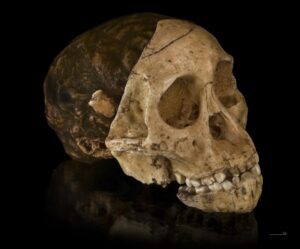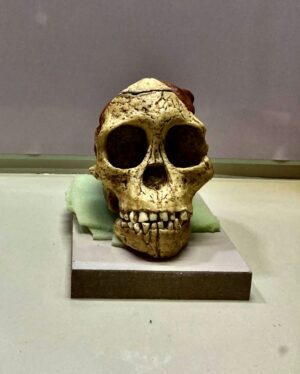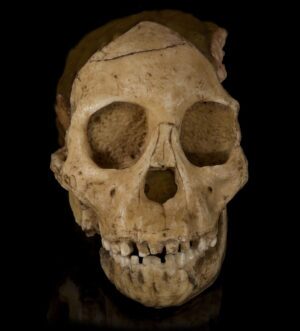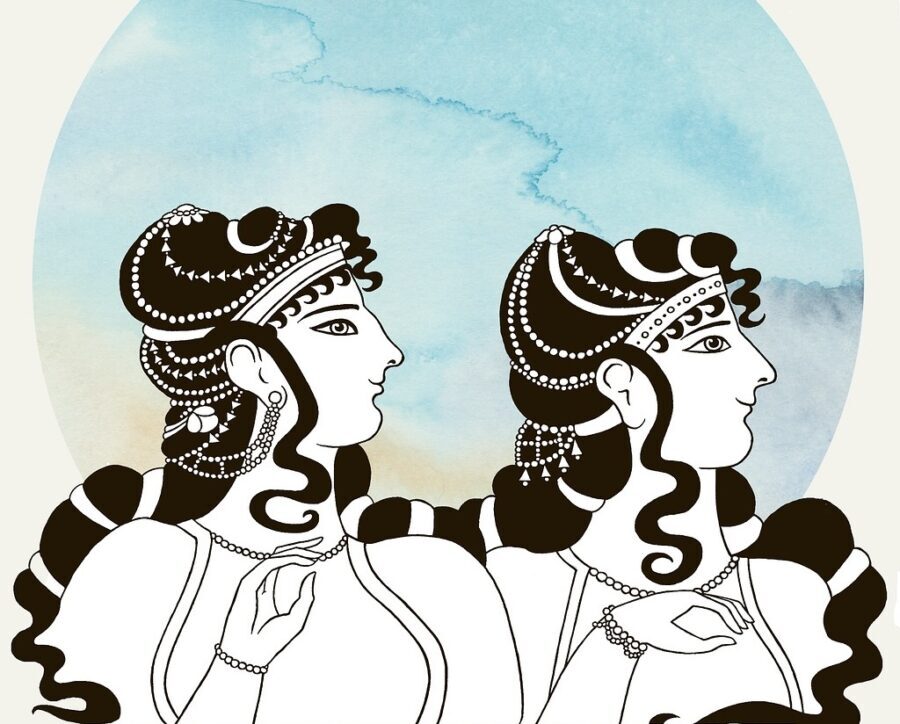
Looking in awe at the tiny skull, set in still silence behind the glass of a centrally placed and carefully guarded and maintained case within the Fossil Primate and Hominid Vault at the University of the Witwatersrand’s Evolutionary Studies Institute, I felt like I was, in a sense, standing in a sacred space. Here, within this vault, scientists have stored and protected some of the world’s most pivotal and significant original fossils bearing on human origins, fossils dated back millions of years into the deep human past.
I was in this vault as part of a small privileged group of human evolution educators and enthusiasts who were given a once-in-a-lifetime opportunity to view, in person, hominin fossils that made history in the story of the human quest to understand our collective, deep prehistoric ancestral human origins.
The skull of what has been penned in the popular literature as the “Taung Child” holds a special significance, even in this iconic vault, among its nearby fossil neighbors….
______________________________

The original Taung Child skull as displayed and protected within the vault.
______________________________
The Taung Child is actually a fossil skull of a young Australopithecus africanus, an extinct species of human relative that lived between about 3.3 and 2.1 million years ago in the Late Pliocene to Early Pleistocene of South Africa. It was initially discovered in 1924 by quarrymen working for the Northern Lime Company in Taung, South Africa. Raymond Dart , an Australian anatomist and anthropologist who lived between 1893 and 1988, described it as a new extinct human species in a published piece in the journal Nature in 1925.
___________________________

TAKE A GLORIOUSLY SCENIC WALKING JOURNEY ON ANCIENT ETRUSCAN PATHS FOR THE EXPERIENCE OF A LIFETIME!
___________________________
The Story
In the early 20th century, the workers at limestone quarries in Southern Africa routinely uncovered animal fossils from tufa formations through which they were mining by the use of explosives. These fossils, many of which represented extinct fauna, were saved by some of the miners. It was in 1924 when workers at the Buxton Limeworks, near Taung, showed a fossilized primate skull that had been recovered from these operations to Edwin Gilbert Izod, the visiting director of the Northern Lime Company. The director in turn gave it to his son, Pat Izod, who displayed it on the mantle over the fireplace. When Josephine Salmons, a friend of the Izod family, visited to Pat’s home, she noticed the primate skull and identified it as that of an extinct monkey. Realizing its potential significance and showed it to her mentor, Raymond Dart. Salmons was the first female student of Dart.
Dart was very excited about the find and asked the Company to send more similarly curious fossil skulls they might find. A consulting geologist for the Company, Robert Young, sent some selected skulls back to Dart in a crate. Anxious to see the finds in the crate, he examined the contents and found a fossil endocast of a skull showing the impression of a complex brain. Upon further search of the crate’s contents, he was able to match the endocast to a fossil skull of a juvenile primate, which exhibited a shallow face and small teeth.
For Dart, this was a remarkable realization. Forty days later, he completed the paper, published in the 7 February 1925 issue of Nature, announcing the discovery of a new species he designated as Australopithecus africanus, meaning “southern ape from Africa”. He described it as “an extinct race of apes intermediate between living anthropoids and man”. For him, this was a pivotal moment in the search for human origins.
The fossil was nicknamed in the popular press as the Taung Child.
Dart’s claim was initially greeted with skepticism and debate for a variety of reasons by the scholarly world, but later discoveries, analysis and developments supported his contention. Most salient were the efforts of two scientists, Robert Broom and Wilfrid Le Gros Clark. Broom, a paleontologist, visited Dart in Johannesburg to see the fossil. He also undertook excavations, and discovered more Australopithecus africanus specimens, corroborating the human-like morphology and classification of the Taung child. In 1946, Broom and colleague Gerrit Schepers published in a volume titled The South African Fossil Men: The Australopithecinae. Clark, a prominent and highly respected British anthropologist, visited Johannesburg in 1946 to study Dart’s Taung skull and Broom’s excavated adult fossils, intending to prove that they were only apes. However, after two weeks of studies and visiting the caves in which Broom had recovered his fossils, Clark became convinced that the Taung Child, and the other fossils discovered by Broom, were in fact those of hominids.
In a much later development in 2006, Lee Berger, a world-renowned South African paleoanthropologist, suggested that the Taung Child was likely killed by a large predatory bird, such as an eagle, citing clear similarities between markings on the skull and eye sockets of the Taung Child to those seen in modern primates known to have been killed by eagles.
____________________________

Above and below: cast in three parts: endocranium, face and mandible, of a 2.1 million year old Australopithecus africanus specimen so-called Taung child, discovered in South Africa.
Collection of the University of the Witwatersrand (Evolutionary Studies Institute), Johannesburg, South Africa. Sterkfontein cave, hominid fossil. Didier Descouens, CC BY-SA 4.0, Wikimedia Commons
____________________________

____________________________
The Centenary of the Taung Child Discovery
On February 7, 2025, the South African Journal of Science published a special issue commemorating the discovery and significance of this iconic fossil. This special issue, ‘The Taung Child then and now: Commemorating its centenary in a postcolonial age’, brings together a group of African researchers and international collaborators who offer their perspectives on the science, history, and legacy of palaeoanthropology in South Africa and beyond. They explore how the history of the discovery of early hominins in South Africa, as it played out in a colonial context, impacted the scientific field of palaeoanthropology, asking: Did it promote or limit scientific enquiry? What were its cultural effects, and how do they play out in our current context a century later? How might we work to decolonize palaeoanthropology and its narratives?
The goal of this special issue is to celebrate the remarkable science that the discovery of A. africanus enabled, but also to probe disciplinary legacies viewed through a critical lens that challenges us to do science better. As we enter the next century of palaeoanthropological research and discovery, the contributors call on researchers to take on board socially responsive practice, and for institutions to hold researchers to higher standards of practice.
Read the special online issue now.
Article Information Source: South African Journal of Science news release
____________________________
Advertisement

EXPLORE THE ANCIENT ETRUSCANS IN PERSON!
Experience a unique, up-close-and-personal hike among ancient hilltop towns in central Italy. You will walk the sensational countryside of the regions of Umbria and Tuscany, soaking in important sites attesting to the advanced Etruscan civilization, forerunners of the ancient Romans; imposing architectural and cultural remains of Medieval Italy; local food and drink; and perhaps best of all — spectacular scenic views! Join us in this collaborative event for the trip of a lifetime!


